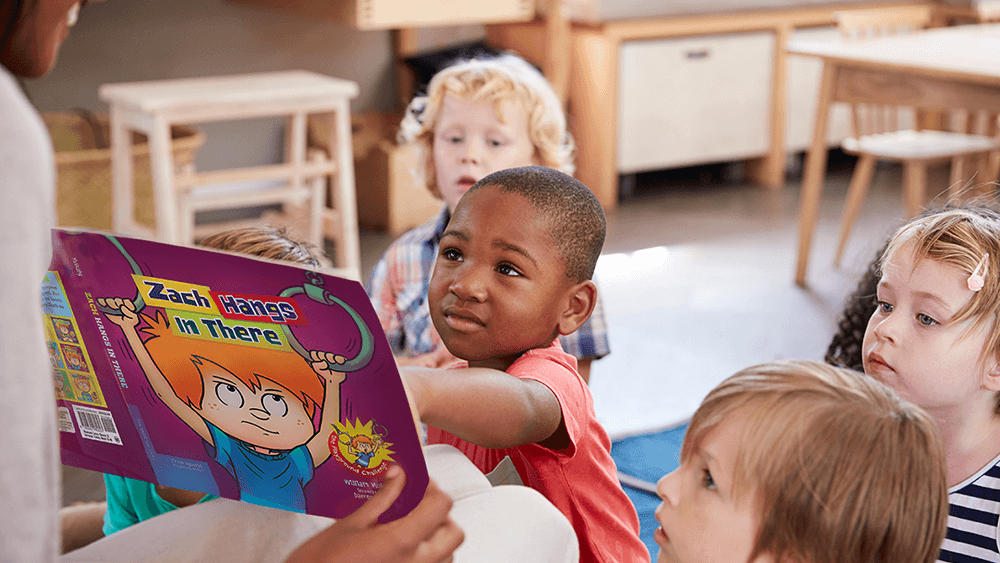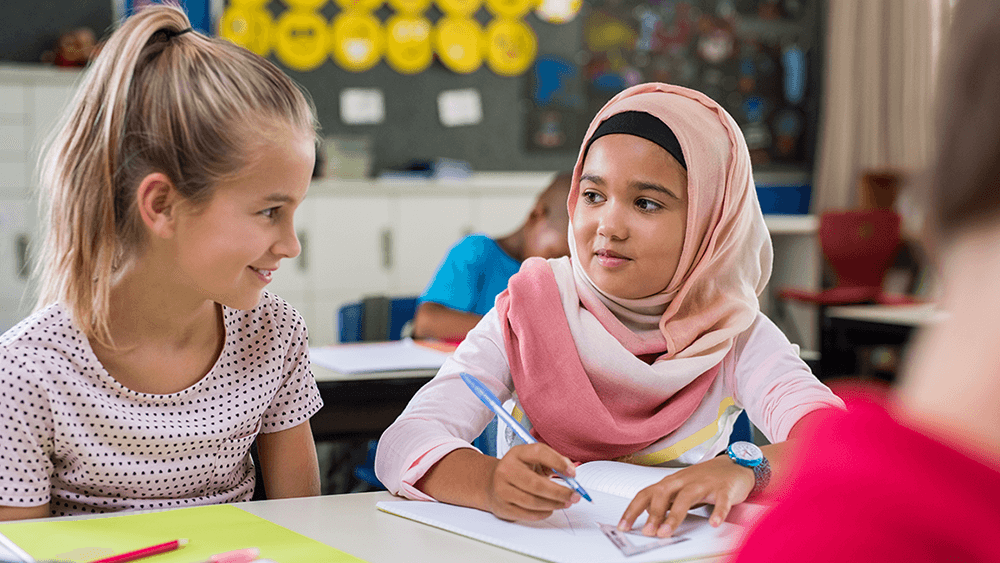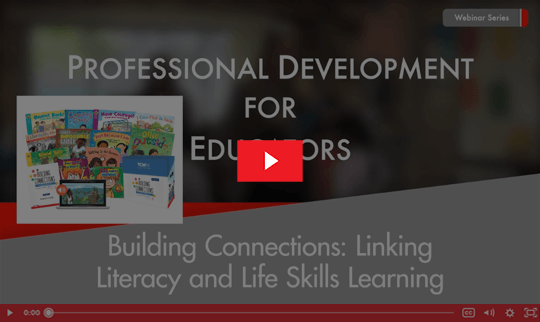Building on the Power of a Read Aloud
Books are the perfect teaching tools. Reading books aloud creates community. Books have the power to instruct, teach lessons, demonstrate life skills, and reflect powerful emotions that students feel. This article will explore ways that interactive read aloud strategies can help link literacy with life skills. Discover three easy-to-implement, meaningful strategies for building an interactive read-aloud that will integrate social and emotional concepts with literacy activities.
Strategies for Linking Literacy and Life Skills Learning
As an educator, one of my favorite things to do with my students is reading aloud to and with them. There is something very special about gathering students around to read a great story, and even better when that story has the power to illuminate shared experiences and to bring us closer together as a community. Great stories and the characters and events within them make the text come alive and create their own sort of magic. We also know the power a story has to instruct, to teach a lesson, to guide students, and to provide examples of life skills the characters may learn along the way. Books are perfect teaching tools because they address the powerful emotions that children feel, model effective coping strategies, and present complex concepts—self-awareness or responsible decision-making, for example—in developmentally appropriate ways.
 Now, possibly more than ever, we know teachers need ways to integrate teaching important life skills within other content areas to maximize instructional time and help their students develop the understanding and skills that support self-awareness, self-management, social awareness, relationship skills, and responsible decision-making. These skills are also known as social-emotional competencies, often called life skills or social skills. We can harness the power of literature and use it to develop social skills like empathy, positive self-talk, problem-solving skills, and more by reading often, carefully curating books, and enjoying interactive read-alouds together. When you pair a carefully selected story with engaging activities designed to build literacy skills like inferencing, compare and contrast, and more, you maximize learning time and capitalize on the benefits of building students’ love of learning.
Now, possibly more than ever, we know teachers need ways to integrate teaching important life skills within other content areas to maximize instructional time and help their students develop the understanding and skills that support self-awareness, self-management, social awareness, relationship skills, and responsible decision-making. These skills are also known as social-emotional competencies, often called life skills or social skills. We can harness the power of literature and use it to develop social skills like empathy, positive self-talk, problem-solving skills, and more by reading often, carefully curating books, and enjoying interactive read-alouds together. When you pair a carefully selected story with engaging activities designed to build literacy skills like inferencing, compare and contrast, and more, you maximize learning time and capitalize on the benefits of building students’ love of learning.
Below you will find easy-to-implement, meaningful strategies for building an interactive read-aloud that will integrate social and emotional concepts with literacy activities.
Choose the Right Text
Carefully curating the text you want to use for the read-aloud may sound easy enough, and in some ways, it is. Choose a text that teaches a life skill, reflects diverse identities and experiences, and provides support for extending the learning beyond the read-aloud.
Teach a life skill
Reading can be an extraordinary tool—to help all students feel a sense of belonging, to feel less alone, and to navigate complex and challenging experiences. According to Colvin (2017), readers who get lost in a book are mentally and emotionally experiencing what is going on in the story. Through these experiences, readers are exposed to new social situations and can feel empathy for characters who may be unfamiliar to them. Readers are building social skills through their interaction with the text. To maximize this benefit, the text you choose as the tool to teach these powerful life lessons is critically important.
You may already have some favorite books picked out that explore important social skills or life lessons. That is a great start! There are additional considerations to make when choosing just the right book to ensure you can connect literacy and life skills learning.

Reflect diverse identities and experiences
Another important consideration when choosing a text is the illustrations and characters found within the text. When students read books that reflect their identities and experiences, they are more likely to make personal connections between the book and their own lives. This is all that much more important when our focus is to teach students life skills like how to wait, to persevere, or to navigate disappointment, for example. As Dr. Rudine Sims Bishop has taught us, books that represent a wide range of thought, ideas, perspectives, cultures, and languages can serve as windows showing children glimpses into new worlds of possibility that may be different than their own or as sliding glass doors allowing them to use their imaginations to step into new realities, to create a better world. Books can also serve as mirrors reflecting children’s own lives and experiences, struggles, hopes, dreams, and joys (Bishop, 1990).
Support extended learning beyond the read-aloud
Look for ways to extend the learning through reflection questions, talking points, and extension activities that encourage reading and writing about the text. For example, the text Waiting is Not Forever by Elizabeth Verdick, has parent and caregiver support in the back of the book. This can help you build important connections between home and school, as well as to find ways to extend your own discussions within the classroom.

Promote Cooperative Learning
Learning is a social activity and grouping students in effective ways sets the stage for engaging conversations and deeper learning around the topic. Engage students in a variety of cooperative learning and partnering strategies that provide time for important reflection and collaboration. Processing and brainstorming collaboratively prepare students to think critically and to relate ideas to their own lives. The questions we ask while reading with students, as well as the activities we engage them in after the read-aloud, can integrate strong social skill focus areas and enhance reading comprehension. After a discussion, or other collaborative learning activity, students are more prepared to demonstrate their learning independently around the important life lessons within text, while also building comprehension and literacy skills.
The more students can discuss and collaborate, the deeper their connections to each other and the lessons within the text will be. Think creatively about how to pair and group students and then you are ready to build literacy and life skills at the same time.
Build on Skills with Activities
Read-alouds enable educators to model fluent reading and expression, while building the literacy and comprehension skills of their learners. This shared experience provides opportunities to engage students in collaborative discussions around key concepts, and provide activities that practice reading, writing, listening, and speaking skills. These and other standards-aligned literacy strategies are designed to support increased comprehension of the text and provide an opportunity for students to demonstrate understanding. It also gives you an important look into the learning that has taken place before, during, and after the read-aloud.
Select reading, writing, listening, and speaking activities that practice literacy and comprehension skills, as well as each of the life skills found within the text. Once you have determined what you will ask the students to do (infer, recall, compare and contrast, or retell, for example), you will want to craft a question and/or activity that draws out that skill connected to the life skills lessons the characters are learning in the story. For example, in the post-reading activity below, students are asked to extend their learning through a discussion prompt, retelling how Casey overcomes boredom in Coasting Casey by Shannon Anderson, and then work independently to draw how Casey turns his snores into scores, showing text evidence.
When a text is carefully curated for the life lessons it can teach and is paired with strong discussions and literacy activities, the true superpowers of the story take hold, allowing you to maximize your learning time and create a powerful experience with your students.
In summary, build on the power of a read aloud by choosing a text that has the capacity to teach a life skill, reflect diverse identities and experiences, and extend learning beyond the read-aloud. Invite students to work together to reflect and collaborate. Finally, select reading, writing, listening, and speaking activities that practice literacy and comprehension skills, as well as each of the life skills found within the text.
Categories:
English Language Arts | Literacy | Reading | Social Emotional Learning | Teaching StrategiesAuthor Bio:
View All AuthorsCarrie Eicher, Academic Officer for Teacher Created Materials
Carrie Eicher is currently serving as an Academic Officer for Teacher Created Materials. In her role, she provides professional development and training on TCM curriculum materials and Shell Education professional resources for school districts, teachers, and educational trainers. Prior to joining TCM, Carrie worked with Dr. Sharroky Hollie as a Consultant and Coach with the Center for Culturally and Linguistically Responsive Teaching and Learning. Carrie started her career in education as a...
Join the TCM Blog Community
Subscribe by sharing your email address and we will share new posts, helpful resources and special offers on the issues and topics that matter to you and the children and teens you support.

